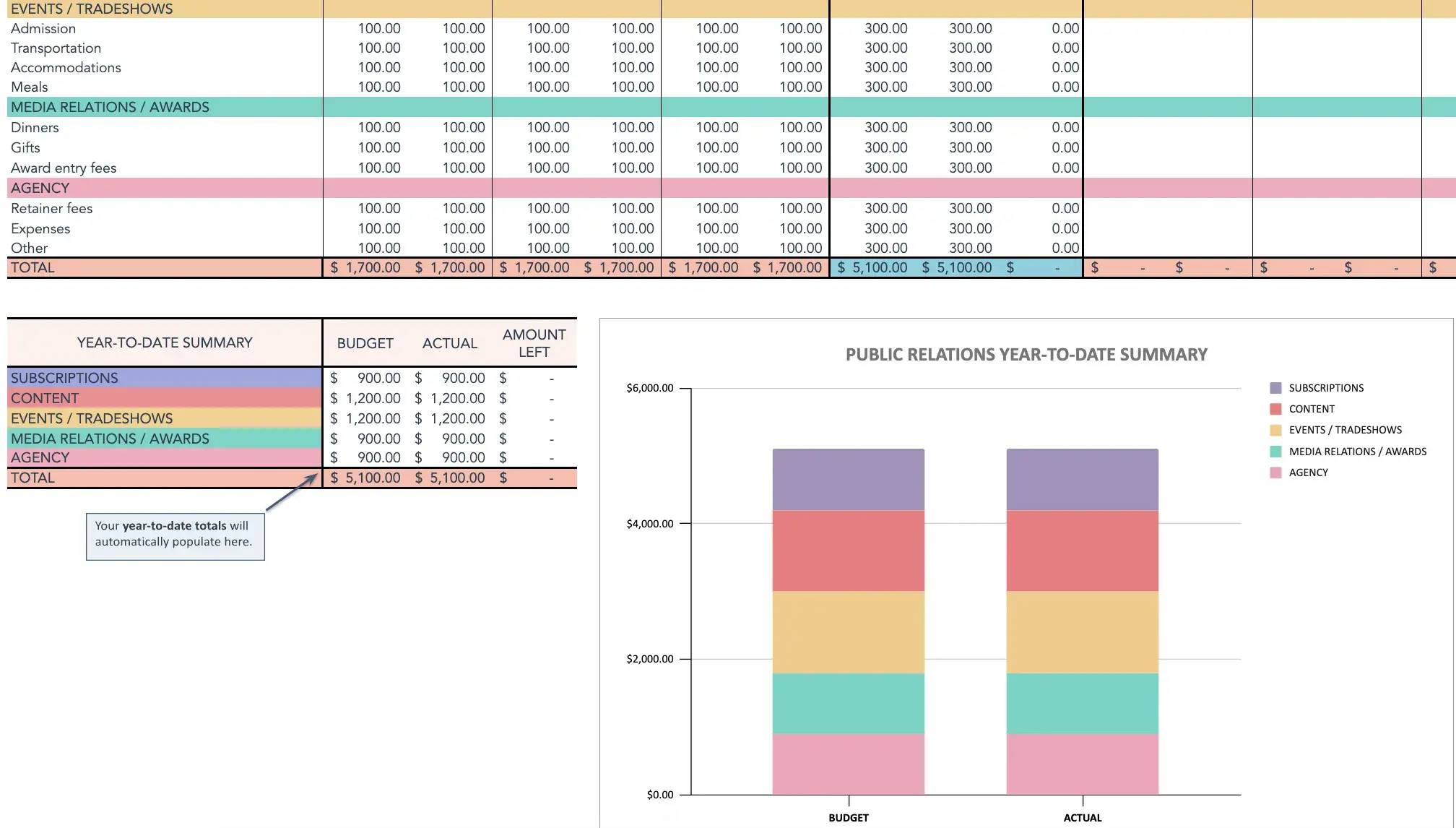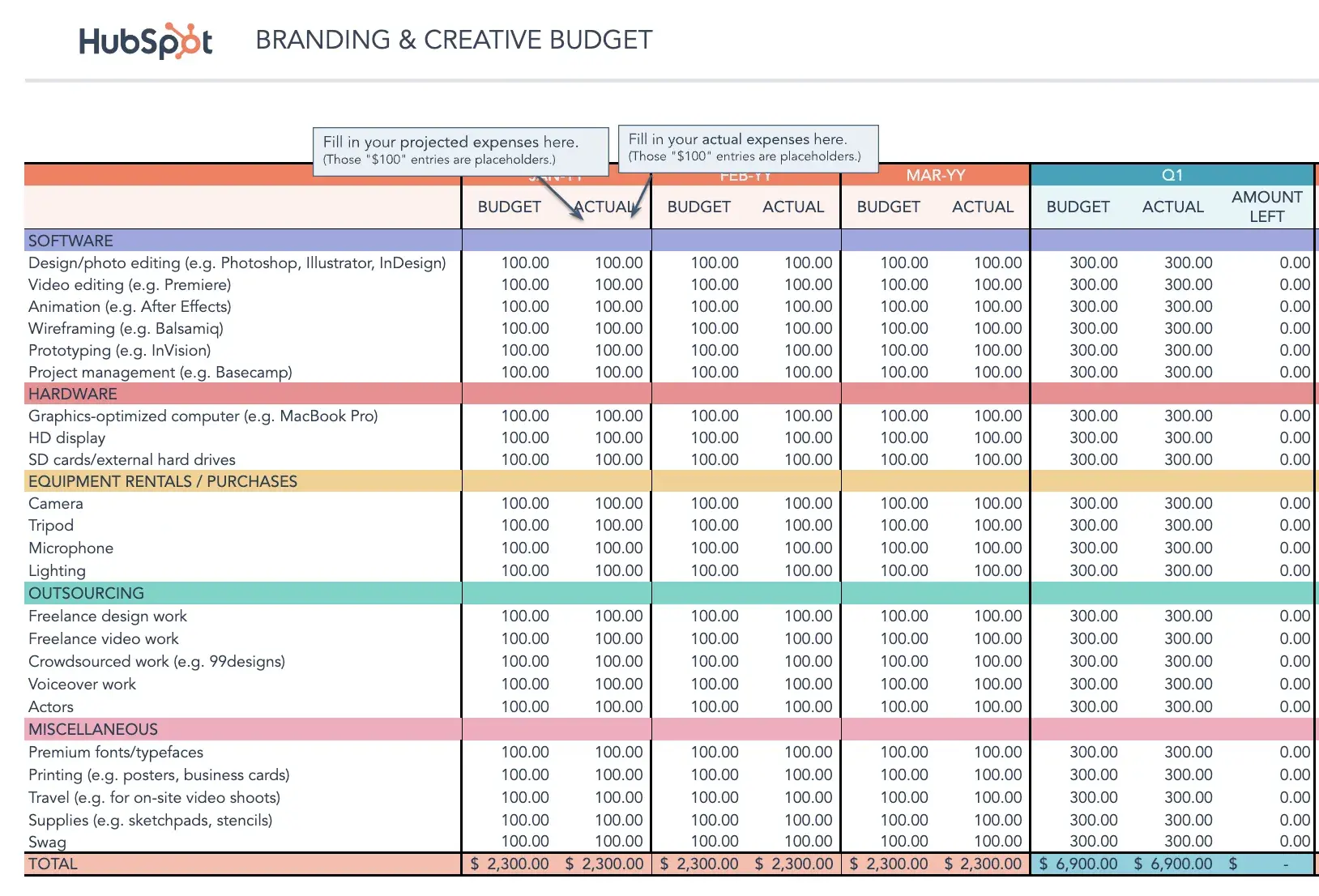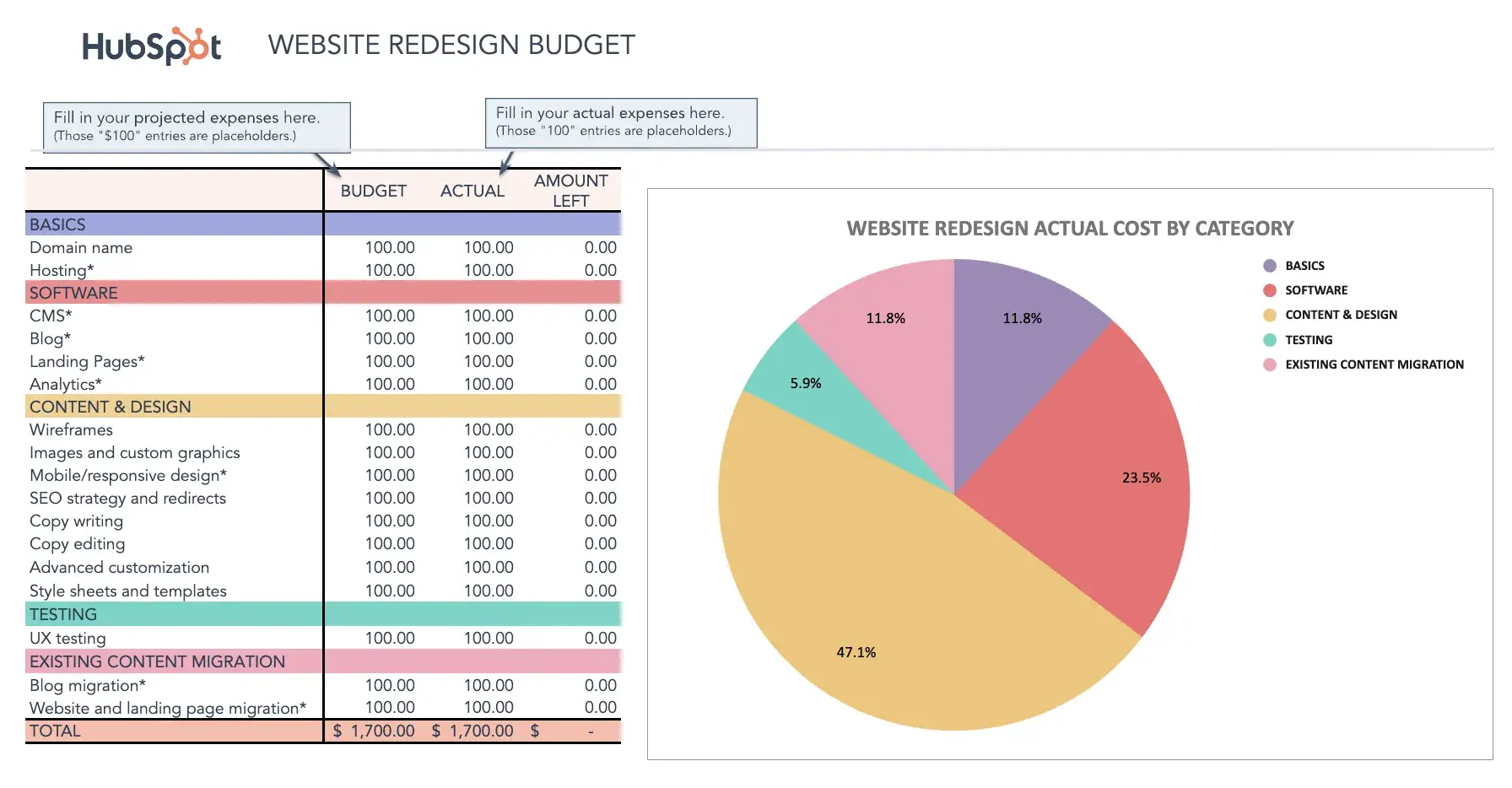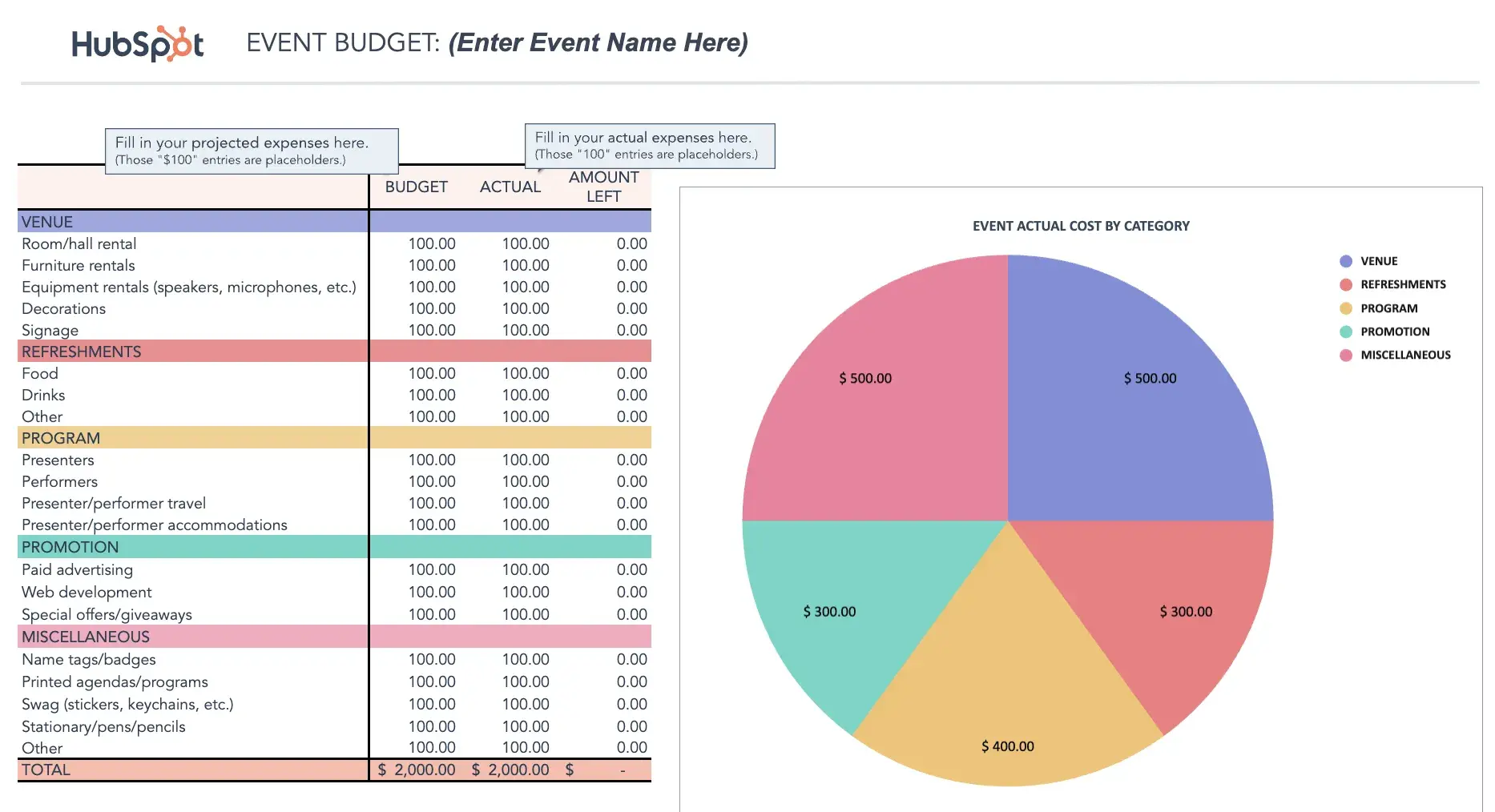The phrase “marketing budget” may cause concern for many marketing leaders, but it is essential when developing a marketing strategy for your company. During budgeting season, I focus on setting a budget that will impact my team’s capabilities and our value to the company. Without adequate funds, my team cannot take advantage of emerging trends or produce high-quality content that resonates with our audience and drives purchases.
In this article, I will share tips on managing your marketing budget based on my experience. Additionally, I will provide eight templates to help you kickstart your budget planning.
What is a marketing budget?
A marketing budget outlines the funds a business plans to allocate towards marketing-related projects over a specified period, such as a quarter or a year. Marketing budgets cover expenses like paid advertising, sponsored web content, hiring new marketing staff, acquiring a blog domain, and investing in marketing automation software.
Marketing investments typically involve advertising products to target customers, increasing brand awareness, and implementing scalable marketing processes.
Advertising efforts may include online ads, email campaigns, and social media posts. Building brand awareness involves creating valuable digital content like blog posts or ebooks to engage customers. Backend marketing processes may incorporate business automation tools or software-as-a-service (SaaS) solutions to streamline operations.
As a marketer, it is crucial to include all these aspects in your budget planning.
Marketing Budgets for Small Business
Marketing budgets are particularly vital for small businesses. Small business owners may lack experience in budgeting and need to keep costs low as they grow. However, marketing is essential for scaling your business and selling products or services. In addition to the templates provided below, consider utilizing free resources and courses to manage your marketing expenses.
Establishing marketing budgets can be challenging for companies of all sizes.
How much should a company spend on marketing?
Digital media accounts for nearly 60% of both U.S. and global advertising spend, targeting audiences across various digital channels like desktop computers, search engines, social media, and mobile devices. Allocating at least half of your budget to digital channels can yield significant results.
Let’s explore other ways to allocate your marketing budget.
Marketing Costs
Marketing costs encompass all expenses incurred by a company to promote its brand, including advertising, software, personnel, and content creation.
Marketing Cost Examples
When building a budget, consider the following items:
1. Software
Marketing tools are essential for completing tasks efficiently. From design software to content creation tools, there are various categories of software that marketers use daily.
Pro tip: Try out free software options before committing to paid tools to manage costs.
2. Freelancers
Freelancers can provide temporary support for projects or campaigns. Consider hiring freelancers for specialized tasks or short-term projects before committing to full-time hires.
3. New Personnel
Some marketing projects may require hiring new staff. Account for costs like equipment, benefits, and onboarding when budgeting for new personnel.
4. Advertising
Allocate funds for promoting your content through various advertising channels like social media, search engines, and native ads.
5. Content Creation
Invest in resources like cameras, actors, and software for creating engaging content that resonates with your audience.
Creating content requires both money and time, as the saying goes, time is money.
Investing paid time in creating content, such as videos, photos, or blog posts, is essential.
Content marketing generates three times more leads than traditional methods, making it a worthwhile investment.
Allocate a budget for creating content and adjust it based on the return on investment.
Understanding what to include in your budget, let’s explore how these funds are utilized.
Marketing Budget Breakdown
Companies typically allocate 7% to 10% of their total revenue to marketing. According to a Gartner CMO survey, marketing budgets as a percentage of revenue decreased to 6.4% in 2021 from 11% the previous year.
If you’re unsure where to start with budget allocation, consider the 70-20-10 rule:
70% of the budget towards proven strategies.
20% of the budget towards new growth strategies.
10% of the budget towards experimental strategies.
Marketing Cost Example
For instance, with a $10,000 marketing budget:
$7,000 could go towards established strategies like successful paid search campaigns and social media marketing.
$2,000 could be allocated for testing new products or services.
$1,000 could be reserved for experimenting with sponsored content.
Allocation by Channel
Budget allocation per channel varies based on company goals. However, the chart below illustrates the distribution of marketing budgets among large companies in different regions.
Image Source
Broken down by channel, social marketing, digital advertising, and SEO lead in marketing budget shares.
Marketers are projected to spend over $740 billion on ads by 2024. Here are some examples of digital marketing costs and how they fit into your budget.
Paid Search Advertising
Google’s pay-per-click (PPC) ads at the top of search results pages are a familiar sight. CPC can range from a few cents to a few dollars, based on Google’s keyword planner.
While your campaign may not use the full budget, you only pay for clicks received.
Social Media
Social media platforms offer PPC-based advertising and charge by impressions. CPC varies by platform, with costs ranging from cents to dollars.
Outsourcing social media campaigns to agencies can cost between $2,000 to $20,000 per month.
Content Marketing
A brand blog is an effective content marketing tool. Costs for content marketing, like case studies or videos, can range from $2,000 to $10,000 per month.
Hiring agencies can yield better results and free up internal resources.
Email Marketing
Email marketing, with a 40X higher customer acquisition rate than Facebook and Twitter combined, is a staple in most budgets.
Costs depend on business size, goals, and chosen platforms, with outsourcing being more expensive.
Search Engine Optimization
SEO improves website visibility on search engines like Google. Agencies can handle SEO needs for thousands per month.
While the options seem vast, focus on what aligns with your goals rather than using every channel available.
Every business is unique, and it is important to allocate funds towards strategies that align with your specific needs.
How to Create a Marketing Budget
Know your buyer’s journey.
Align your budget with your marketing goals.
Beware of hidden costs.
Remember where your priorities lie.
Spend your budget smartly.
Prepare to measure ROI.
Simply having knowledge of spreadsheets is not enough to effectively plan how you will allocate your marketing budget for the year.
Establishing a solid marketing budget begins with understanding the purpose of the budget and the marketing teams it represents.
Here is my approach to creating a marketing budget:
1. Know your buyer’s journey.
The buyer’s journey outlines the steps your audience takes from being a prospect to becoming a paying customer.
Understanding my buyer’s journey helps me analyze how my audience engages with my marketing efforts. This insight allows me to set appropriate goals and allocate budget effectively to reach my customers.
When defining my buyer’s journey, I consider the following questions:
How do customers typically discover my products?
What information do they need before making a purchase?
How much traffic does my website receive monthly?
What is the conversion rate of leads to customers?
What is the cost of acquiring new leads and converting them to customers?
What is the average revenue generated by each lead?
This process helps identify the effectiveness of marketing tactics, adjust goals, and focus the marketing budget accordingly.
2. Align your budget with your marketing goals.
Your budget allocation should align with your marketing objectives.
When creating a marketing budget, ensure that you are spending on activities that support your current goals, which are based on your audience and their journey from prospect to customer.
These activities may include:
Display ads for a new product launch.
Sponsored social media posts to increase followers.
Paid search engine ads to drive traffic to specific pages.
Collaboration with bloggers for organic search traffic.
According to Jessica Webb Kennedy, former Demand Generation Marketer at HubSpot and current Head of Marketing at Hummingbirds, the distribution of costs varies when focusing on lead generation versus lead conversion.
Kennedy explains, “Budget allocation for paid campaigns is often based on click volume or impressions. Therefore, campaigns with higher volume offers and audiences usually receive more budget.”
For instance, promotional efforts aimed at lead generation receive more clicks compared to those targeting the middle or bottom of the funnel. The cost of paid advertising also depends on the audience size and targeting options.
“Twitter advertising demonstrates this well,” Webb says. “Campaigns can be targeted based on interests or keywords searched by users.”
She adds, “Interests targeting reaches a larger audience and requires a higher budget compared to keyword targeting.”
3. Beware of hidden marketing costs.
Maintaining a budget spreadsheet helps avoid unexpected costs that may arise towards the end of a quarter or year.
For example, product marketing involves more than just promotional activities. Meghan Keaney Anderson, former HubSpot VP of Marketing and current head of product marketing at Watershed, emphasizes the importance of conducting research and message testing before product launch.
Anderson states, “Conversations with customers about their pain points are crucial in shaping messaging for a successful product launch.”
4. Remember where your priorities lie.
It is essential to differentiate between essential expenses and add-ons in marketing. Keeping track of budget allocation and evaluating the results helps in determining which expenses are necessary and which can be eliminated.
For instance, in public relations, it is easy to overspend on tools that may not provide significant value. Nathaniel Eberle, former director of PR at HubSpot and current VP of global brand and creative management at GoTo, advises focusing on tools that help target key stakeholders and measure effectiveness.
Eberle suggests, “Teams should concentrate on the audience they aim to influence and reach.”
Then, teams can revisit their budgets and ensure that the spend supports initiatives that appeal to said audience.
“As the media and digital landscape evolves at breakneck speed, continually reassessing the tools, services, and programs you‘re employing is a great way to determine real-time ROI of your overall spend. Today’s measurement tool may be worthless to you tomorrow,” Eberle says.
5. Spend your budget smartly.
When you open up these budget templates and check out all the various expenses detailed in them, don‘t fret if you can’t tick every box. I’m not advocating for an “always spend more” approach to marketing.
I‘m advocating for an “always spend smart” approach. The expenses listed out aren’t mandatory — they‘re just meant to guide your thinking and to help ensure that you haven’t overlooked any hidden costs.
6. Prepare to measure ROI.
When I put a certain amount of money into a certain area, I want to determine if my budgeting helped or hurt me as I plan out future budgets. The best way to do this is by measuring ROI — or return on investment.
If the money I’ve spent on one item results in my company making more in return, I may want to increase the budget in the next year. If my money doesn’t end in returns, I re-examine my budget.
Marketing Budget Templates
Using a marketing budget template can be useful when you’re not sure how to split or track your marketing costs.
For instance, let’s say your company decided to invest in a website redesign to improve lead generation, and you’re responsible for managing the project.
Naturally, one of the first questions you ask is, “How much is this website redesign going to cost?”
The answer, of course, is “it depends.” Are you simply switching to a new template and adding some new CTAs, or are you migrating your entire website to a new platform?
If only there were a way to organize your answers to all of these questions — a place where you could enter in estimated costs for all of your line items and then compare your projected marketing budget to what you actually end up spending. Good news: Marketing budget templates can help.
Included in our eight marketing budget templates bundle is a template to manage your website redesign … as well as templates for both Excel and Google Sheets to help you track your content budget, paid advertising budget, event budget, and more.
With these templates, you’ll be able to manage all of the moving pieces of your budget at a monthly and quarterly level.
Use the Excel version of the templates to keep all of your budgets in one place.
When you download the zip file, you’ll find a separate file for each marketing team, as well as a Master Budget Template to maintain a high-level view of your overall expenses.
Interested in sharing your marketing budget across a larger team?
Try the Google Sheets version of our templates to share access with other Gmail users. For the Google Sheets templates, each team budget is found in a separate tab of the same Google Sheet.
No matter which version you choose, each budget is optimized with the same line items, tips, and graphs. Read on to learn how to use each budget template.
1. Master Marketing Budget Template
Download the Master Marketing Budget Template here.
While it‘s helpful to have individual budget templates for specific marketing departments and activities, it’s also nice to be able to take a step back and see the bigger picture.
The Master Marketing Budget Template lets you do just that: It’s the place where you can collect the totals from the other seven templates in the bundle and see all of your expenses in one place.
Tour
Budget Overview from All Departments: In the first table, you get to see both your budget and actual spending from all marketing departments, including product marketing, content marketing, paid advertising, PR, branding and creative, and events.
Month-Over-Month Expense Summary: For a more bird’s eye view of all expenses, look at this table, where you can see the aggregated budget and actual spending for all marketing activities.
Marketing Budget vs. Actual Spend Chart: This chart allows you to pinpoint trends in spending and budgeting — where you came under and where you over-spent.
2. Product Marketing Budget Template
Download the Product Marketing Budget Template here.
This template will guide you step-by-step through the process of budgeting for a product launch.
From determining product/market fit, to running user testing sessions, to promoting your finished product, our Product Marketing Budget Template will help ensure you don’t overlook any important expenses.
Tour
Budget & Spend per Product Marketing Activity: This table allows you to set a budget and track your spending for product marketing activities such as carrying out focus groups, hosting launch events, and creating white papers.
Year-to-Date Summary of Categorical Expenses: Here, you can see an aggregated summary of all expenses divided by category, such as product release spending and product testing. It will also automatically calculate the amount of money you have left.
Year-to-Date Summary Chart: This chart allows you to see a visual breakdown of where most of your funds are going, which is immensely helpful for figuring out where to scale back and where to invest more.
3. Content Budget Template
Download the Content Budget Template here.
The budget required for creating and promoting content can vary greatly from organization to organization.
For example, while some organizations keep most of their content operations in-house, others rely more heavily on freelancers and contractors.
And while some use many different software products, publishing tools, and services, others take a much simpler approach.
Our Content Budget Template is designed to cover as many content-related bases as possible.
So, if you see any expenses listed that don‘t apply to your organization, go ahead and delete them.
(That’s the beauty of Excel spreadsheets: You can customize them to your specific needs.)
Tour
Budget & Spend per Content Marketing Activity: This table allows you to set a budget and track spending for content marketing activities, such as purchasing design software, creating landing pages, and hiring freelance writers.
Year-to-Date Summary of Categorical Expenses: Here, you can see an aggregated summary of all expenses divided by category, such as software purchases and freelancer costs. It will also automatically calculate the amount of money you have left.
Year-to-Date Summary Chart: This chart allows you to see a visual breakdown of where most of your funds are going, which is immensely helpful for figuring out where to scale back and where to invest more.
4. Paid Advertising Budget Template
Download the Paid Advertising Budget Template here.
Paid advertising: Does it really qualify as an inbound marketing tactic/channel? That is a loaded question, my friends, and one that I don’t have room to answer in-depth in this post.
What I can tell you for sure is that you can do paid advertising in an “inboundy” way — i.e. by targeting specific buyer personas and using paid advertising as a supplement to your organic efforts to help drive awareness and conversion opportunities.
Measuring the effectiveness of your paid advertising campaigns is also paramount to doing things the inbound way.
Using our Paid Advertising Budget Template, you can keep tabs on your monthly (and quarterly) ad spending and then cross-reference the amounts with your lead-generation metrics to determine your cost-per-lead.
Tour
Budget & Spend per Paid Advertising Activity: This table allows you to set a budget and track spending for paid advertising activities, such as launching CPC campaigns, creating social media ads, and investing in a content discovery platform.
Year-to-Date Summary of Categorical Expenses: Here, you can see an aggregated summary of all expenses divided by category, such as search advertising and lead generation. It will also automatically calculate the amount of money you have left.
Year-to-Date Summary Chart: This chart allows you to see a visual breakdown of where most of your funds are going, which is immensely helpful for figuring out where to scale back and where to invest more.
5. Public Relations Budget Template
Download the Public Relations Budget Template here.
Public relations expenses amount to more than just paying for press releases.
From reputation monitoring software to traveling (e.g., to events and trade shows) to applying for awards, there are many PR costs that can be all too easy to overlook.
To ensure you‘re accounting for all of your organization’s PR-related expenses, check out our Public Relations Budget Template.

Tour
Budget & Spend per Public Relations Activity: This table allows you to set a budget and track spending for PR activities, such as purchasing a press release service subscription, creating PR content, and hosting PR dinners.
Year-to-Date Summary of Categorical Expenses: Here, you can see an aggregated summary of all expenses divided by category, such as subscriptions, content, tradeshows, and media relations. It will also automatically calculate the amount of money you have left.
Year-to-Date Summary Chart: This chart allows you to see a visual breakdown of where most of your funds are going, which is immensely helpful for figuring out where to scale back and where to invest more.
6. Branding & Creative Budget Template
Download the Creative Budget Template here.
In order to produce high-quality, innovative graphics, videos, and other content, the branding and creative teams of today need more than just Photoshop … a lot more. One of the largest — and often most overlooked — expenses is storage.
If your organization is producing a lot of video, storage is especially important.
Because as it turns out, when budgeting for video storage, you shouldn’t be thinking on a megabyte (MB) or even a gigabyte (GB) scale, but on a terabyte (TB) scale. FYI: 1 terabyte = 1 trillion bytes.
You can keep track of all your storage costs (and other branding and creative costs) using our free template.

Tour
Budget & Spend per Branding & Creative Activity: This table allows you to set a budget and track spending for branding and creative activities, such as purchasing creative software, investing in hardware, and renting equipment.
Year-to-Date Summary of Categorical Expenses: Here, you can see an aggregated summary of all expenses divided by category, such as software subscriptions, equipment rentals, and outsourcing costs. It will also automatically calculate the amount of money you have left.
Year-to-Date Summary Chart: This chart allows you to see a visual breakdown of where most of your funds are going, which is immensely helpful for figuring out where to scale back and where to invest more.
7. Website Redesign Budget Template
Download the Website Redesign Budget Template here.
Budgeting for a website redesign can be seriously tricky. With so many moving pieces to consider, there is a lot of room for underestimating or miscalculating costs.
We created our Website Redesign Budget Template so you can keep all of your redesign-related expenses in one convenient location.
Unsure if your current website is right for a redesign? Grade your website using this tool.

Tour
Budget & Spend per Website Redesign Activity: This table allows you to set a budget and track spending for website redesign activities, such as purchasing a domain name, investing in CMS software, and creating wireframes.
Year-to-Date Summary of Categorical Expenses: Here, you can see an aggregated summary of all expenses divided by category, such as software, content and design, and content migration.
It will also automatically calculate the amount of money you have left.
Website Redesign “Actual Cost by Category” Pie Chart: This chart allows you to see a percentage breakdown of where most of your funds are going, which is immensely helpful for figuring out where to scale back and where to invest more.
8. Event Budget Template
Download the Event Budget Template here.
When planning an event, the associated costs can seem obvious at first.
There‘s the venue to consider, of course. And the P.A. system and microphones.
And then, the costs associated with booking and bringing in presenters/performers.
That’s pretty much it, right?
Wrong.
For example, does the venue come with tables/chairs, or will you have to rent those separately? Do you want your attendees to wear name tags, and if so, will you be printing out the name tags ahead of time or will attendees be writing their own names on blank tags?
If the latter, have you factored in the pens or markers you’ll need to accommodate that? As you can see, planning for an event can lead you down many rabbit holes.
Use our Event Budget Template to stay organized.

Tour
Budget & Spend per Event Hosting Activity: This table allows you to set a budget and track spending for event hosting activities, such as renting an event hall, purchasing food and drinks, and hiring presenters.
Year-to-Date Summary of Categorical Expenses: Here, you can see an aggregated summary of all expenses divided by category, such as revenue, refreshments, and promotion. It will also automatically calculate the amount of money you have left.
Event “Actual Cost by Category” Pie Chart: This chart allows you to see a percentage breakdown of where most of your funds are going, which is immensely helpful for figuring out where to scale back and where to invest more.
Sample Marketing Budget
With your chosen template downloaded, it‘s time to consider which digital channels to allot a budget for.
Hint: There’s no right answer — it’ll depend on the market research you do to figure out where your specific audience spends most of its time.
If you find your buyer prefers learning and consuming content in the form of video, for example, you might invest more of your money in YouTube advertising.
Advertising Budget Example
Here‘s a small sample budget for a quarter’s worth of expenses by a hypothetical company that has decided to invest heavily in video marketing.
This template was created using the Master Budget Template, the first template listed in the section above.
Based on the figures above, video advertising‘s total expenses for the quarter exceeded budget by $20, while full-time recruitment’s total expenses exceeded budget by $2,400. This means the company is trending over budget for the first three months of the year.
Why might this happen? Perhaps a pay-per-click (PPC) campaign on YouTube received more clicks by viewers than expected, and a sharp video-savvy job candidate negotiated a higher salary.
Based on the difference between this company’s planned spend and actual spend, their budget template produced the following graph:
What is an advertising budget?
Your advertising budget is a subset of your marketing budget. An advertising budget is the total amount you expect to spend on creating, testing, and running advertisements that (hopefully) engage consumers.
Advertising budgets also cover the cost of evaluating ad performance and making necessary changes if ads aren’t meeting expectations.
Marketing Budget vs. Advertising Budget
While marketing and advertising budgets aim to capture consumer interest and increase sales, marketing budgets encompass this process end-to-end. Advertising budgets focus on creating awareness and engaging customers.
As a result, advertising budgets fall under the larger purview of marketing budgets. While ad budgets often represent the largest portion of marketing budgets, ads are only effective when combined with larger marketing efforts such as audience targeting and customer follow-up when ads capture interest.
What to Include in an Ad Budget
Six costs form the core of effective ad budgets.
1. Internal Resources
Internal resources include both people and purchases.
The amount of time staff spend working on ad campaigns plus the total cost of their wages for this time gives your total people cost.
The longer it takes to create ads and the more people are required to make these ads, the higher your spending.
Purchases, meanwhile, may include software or hardware that staff need to create and manage great ads.
For example, you might spend on business process automation (BPA) solutions to streamline key proceeds, or new laptops for advertising teams so they can work on the go.
2. Market Research
If you don’t know the market, your ads will miss the mark. As a result, every ad budget should include the cost of both micro and macro market research.
From a macro perspective, it’s worth understanding trends at scale — what do customers want from ads, and what do they want to avoid?
On the micro side, businesses need to target specific segment behaviors. For example, what type of ads are most effective in engaging first-time viewers? Which advertisements connect with existing customers?
3. Third-Party Providers
Advertising agencies can help improve market targeting and create compelling ads. Opting for third-party providers also lets your team focus on current campaign management and long-term strategy development.
Services offered by ad agencies range from consulting to market testing to ongoing ad management, making them a key line item in any advertising budget.
4. Asset Creation
It’s also important to account for any asset creation costs as part of ad budgets. These costs could include graphic designers, web designers, freelance copywriters, video creators, or social media influencers.
5. Ad Space Spending
Advertisements won’t drive revenue if no one sees them. To get your ads noticed, you’ll need to spend on digital or physical space.
Examples of physical ads include bus benches, billboards, and magazine ads. Digital ads can appear on search pages, web pages, social media sites, or on mobile apps.
6. Performance Evaluation
Finally, part of your budget has to focus on performance evaluation.
Here, spending typically focuses on software tools capable of tracking and managing ad efficacy.
Common metrics to consider include the total number of ad views, customer actions, and the overall impact of ads on sales volumes.
To calculate your potential ad budget, add up the costs of these six components. For first-time budgeting, set slightly higher budget caps. If you have past data on ad performance, use it to estimate costs.
Ad budgets often fluctuate due to rising digital advertising costs and changing customer expectations.
It’s wise to allocate some extra budget in case ads underperform or successful campaigns could benefit from increased reach.
How to Set & Monitor Your Ad Budget
Advertising budgets are dynamic and change in response to business objectives and consumer needs.
To make the most of your ad budget, establish a baseline and track metrics over time. Here’s how to do it:
Setting An Ad Budget
Follow these steps to set your ad budget:
1. Decide on a strategy.
Set an advertising strategy before assigning a budget to avoid overspending. Focus on channels where your target audience is most active.
Tip: Adapt to where your customers are, not where you want them to be.
2. Set measurable goals.
Establish measurable goals to track ad performance. Monitor customer behavior and gather feedback to understand the impact of your ads.
Tip: Start with a few key metrics to avoid information overload.
3. Do your research.
Research customer preferences and expectations to tailor your ads effectively.
Tip: Gather insights from various sources to understand customer needs and preferences.
With a clear strategy, goals, and research data, you can create a realistic ad budget to target and engage your audience effectively.
Monitoring Your Budget
Monitor your budget by tracking these key metrics:
1. Return on Ad Spend (ROAS)
Use ROAS to determine if your ads are profitable. A higher ROAS indicates better performance, while values below 1 mean ads cost more than they generate in revenue.
Tip: Combine ROAS with customer data to gain deeper insights into ad performance.
2. Conversion Rate
Measure how often customers take a desired action after viewing an ad. Track conversion rates regularly to optimize ad effectiveness.
Tip: Monitor conversions frequently to make timely adjustments to your ads.
3. Cost per Lead (CPL)
Calculate CPL to understand how much it costs to generate leads. Consider both ROAS and CPL to assess overall ad performance.
Tip: Use A/B testing to reduce CPL and optimize ad campaigns before launch.
Create Marketing and Advertising Budgets That Prioritize Your Goals
A well-planned marketing budget is essential for achieving your team’s objectives and success.
Sure, here is the content rewritten while keeping the HTML tags intact:
“`html
Welcome to our website!
Here, you will find all the information you need about our products and services. Feel free to browse through our site and contact us if you have any questions.
“`
Source link























